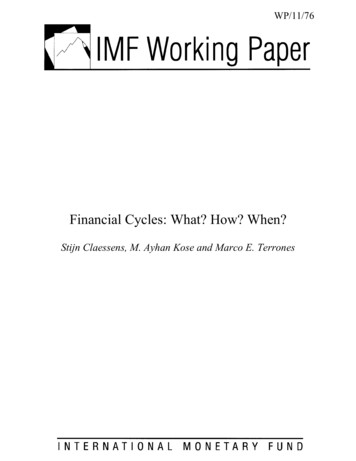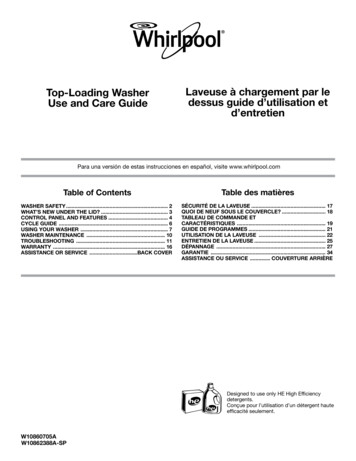
Transcription
WP/11/76Financial Cycles: What? How? When?Stijn Claessens, M. Ayhan Kose and Marco E. Terrones
2011 International Monetary FundWP/11/76IMF Working PaperResearch DepartmentFinancial Cycles: What? How? When?Prepared by Stijn Claessens, M. Ayhan Kose and Marco E. Terrones1April 2011This Working Paper should not be reported as representing the views of the IMF.The views expressed in this Working Paper are those of the author(s) and do not necessarilyrepresent those of the IMF or IMF policy. Working Papers describe research in progress by theauthor(s) and are published to elicit comments and to further debate.AbstractThis paper provides a comprehensive analysis of financial cycles using a large databasecovering 21 advanced countries over the period 1960:1-2007:4. Specifically, we analyze cyclesin credit, house prices, and equity prices. We report three main results. First, financial cyclestend to be long and severe, especially those in housing and equity markets. Second, they arehighly synchronized within countries, particularly credit and house price cycles. The extent ofsynchronization of financial cycles across countries is high as well, mainly for credit and equitycycles, and has been increasing over time. Third financial cycles accentuate each other andbecome magnified, especially during coincident downturns in credit and housing markets.Moreover, globally synchronized downturns tend to be associated with more prolonged andcostly episodes, especially for credit and equity cycles. We discuss how these findings canguide future research on various aspects of financial market developments.JEL Classification Numbers: E32; F42; G12; G15Keywords: Credit booms; credit cycles; asset busts; crunches; house prices; equity prices.Author’s E-Mail Address:sclaessens@imf.org, akose@imf.org, mterrones@imf.org1We are grateful for helpful comments from Frank Diebold, Sandra Eickmeier, Charles Engel, Marty Feldstein,Michael Klein, Lucrezia Reichlin, Ken West, Frank Warnock, and especially our discussants, Jeff Frankel, SteveCecchetti, and Carmen Reinhart. We wish to thank participants of the 2010 NBER ISOM Conference, 2011 AEAMeetings, the Turkish Economic Association International Conference on “The Global Economy after the Crisis:Challenges and Opportunities,” and other workshops where earlier related work was presented. We thank DavidFritz and Ezgi Ozturk for providing outstanding research assistance.
2ContentsPageExecutive Summary .3Figure A. Financial Cycles: Duration and Coincidence .4I. Introduction .5II. Database and Methodology .7III. What are the Main Features of Financial Cycles? .10A. Frequency, Duration, Amplitude and Slope.10B. Synchronization of Financial Cycles.12IV. When do Financial Cycles Become More Intense? .13A. Intense Financial Cycles: Financial Disruptions and Booms.13B. Implications of the Coincidence of Financial Cycles.14V. Duration and Amplitude of Financial Cycles: A Formal Analysis .17A. Duration of Downturns .17B. Amplitude of Downturns and Upturns .18VI. Conclusion .19Tables1A. Financial Cycles: Basic Features .241B. Financial Cycles: Basic Features.252. Synchronization of Cycles within Countries .263. Synchronization of Cycles across Countries.274. Financial Downturns and Upturns .285. Likelihood of Financial Cycles .296. Credit Cycles Associated with Financial Disruptions and Booms .307. House Price Cycles Associated with Financial Disruptions and Booms .318. Equity Price Cycles Associated with Financial Disruptions and Booms .329. Synchronized Financial Downturns .3310. Determinants of the Duration of Financial Downturns: Bivariate Regressions .3411. Determinants of the Amplitude of Financial Downturns: Bivariate Regressions.35Figures1. Financial Cycles: Downturns/Upturns and Disruptions .222. Evolution of Financial Disruptions and Booms .23References .36
3EXECUTIVE SUMMARYGyrations in financial markets have greatly influenced real activity around the world over thepast two decades. Following the largest housing bubble in its modern history, Japan experienceda massive asset market crash in the early 1990s, which marked the start of its “Lost Decade.”After prolonged credit booms, many emerging economies in Asia faced deep financial crises inthe second half of the 1990s. The equity market booms of the late 1990s in many advancedeconomies ended with simultaneous busts and recessions. The 2008-2009 crisis is the latest in along list of economic events shaped by cycles in financial markets.The severity of the latest crisis has made the study of financial cycles a central topic of research.Although there have been many studies covering various aspects of fluctuations in financialmarkets, research has yet to provide a comprehensive analysis of these cycles using objectivemethods, such as those widely used for the study of business cycle. The objective of this paper isto fill this gap using a rich dataset of 21 “advanced” OECD countries for the period 1960:12007:4. We exclude from our analysis the years following the recent crisis because a number offinancial cycle episodes associated with the crisis are still ongoing. Our paper answers threespecific questions. What are the main features of financial cycles? First, financial disruptions tend to belong whereas booms are relatively short (see Figure A). Second, equity and house pricescycles are typically longer and more pronounced than credit cycles. Third, the features offinancial cycles have changed over time; in particular, equity price cycles have becomeshorter. How synchronized are financial cycles within and across countries? Cycles in creditand house prices appear to be the most highly synchronized within countries. The degree ofsynchronization across countries is the highest for credit and equity cycles, and has beenincreasing over time. When does the coincidence of financial cycles lead to intense outcomes? There arestrong feedback effects between house price and credit cycles as disruptions in one marketintensify the other, probably because of collateral constraints and other complementaritiesbetween credit and housing finance. Globally synchronized financial downturns result inlonger and deeper episodes, especially for credit and equity cycles.We employ various regression models to analyze how a wide range of factors help explain theduration and amplitude of financial cycles. We find positive duration dependence for thedownturn phase of financial cycles, implying that the longer a downturn has gone on, the morelikely it is to end. The regression results also confirm the presence of feedback effects betweencycles in different financial markets, even after controlling for other potential factors.Our analysis is relevant to current policy debates, in particular regarding the role of financialmarkets in the real economy and the design of macro-prudential approaches. We conclude with abrief discussion of these issues and directions for future research.
4Figure A. Financial Cycles: Duration and CoincidenceFinancial disruptions tend to be long(duration, number of quarters, average)20 whereas booms are relatively short(duration, number of quarters, 158104500CreditHouse PriceEquity PriceCreditHouse PriceEquity PriceCredit cycles accompanied with cycles inhousing typically last longer and are also more pronounced(duration, number of quarters, average)(amplitude, percent, median)108without busts / booms8with busts / boomswithout busts / booms6with busts / booms46204-22-40House Price BustHouse Price Boom-6House Price BustHouse Price BoomNotes: Duration for downturns is defined as the number of quarters between peak and trough. Duration for upturns isdefined as the time it takes to attain the level at the previous peak after the trough. Disruptions (booms) correspondto the bottom (top) 25 percent of downturns (upturns) in terms of amplitude. Downturns (upturns) refer to episodesother than disruptions (booms). A credit downturn (or upturn) is accompanied with a housing bust (boom), if it startsat the same time or after the beginning of an ongoing housing episode.
5I. INTRODUCTIONGyrations in financial markets have greatly influenced real activity around the world over thepast two decades. Following the largest housing bubble of modern history, Japan experienced amassive asset market crash in the early 1990s which marked the start of its “Lost Decade.” Afterprolonged credit booms, many emerging countries in Asia faced major financial crises in thesecond half of the 1990s. The equity market booms of the late 1990s in a number of advancedeconomies ended with synchronized busts and cyclical downturns. Many countries enjoyedcredit and housing booms over 2003-2007 as the global economy registered its best performanceof the past four decades. However, these episodes also ended with severe financial disruptions inthe form of credit crunches and asset price busts, and resulted in the deepest financial crisis sincethe Great Depression. Not surprisingly, understanding financial cycles has become an importantresearch topic.The objective of this paper is to provide a comprehensive empirical overview of financial cycles.We ask three specific questions. First, what are the main features of financial cycles? Second,how synchronized are financial cycles within and across countries? Third, when does thecoincidence of cycles lead to magnified financial outcomes? In order to answer these questions,we employ an extensive database of cycles in credit, house prices, and equity prices for a largenumber of advanced countries over a long period.Although there is a rich literature analyzing various aspects of financial market developments,our understanding of financial cycles is still limited.2 This reflects the simple fact that most ofthe literature considers only selected aspects of financial cycles. For example, a number ofstudies examine the implications of only booms in asset prices and credit, rather than consideringfull cycles in these markets. Others focus on financial crises―in many respects only the extremeversions of the downturn phases of cycles.We extend the literature on financial cycles in a number of dimensions. First, we provide the firstdetailed, cross-country empirical analysis documenting the main features of financial cycles andthe interactions across different cyclical phases using a large sample. Second, in parallel with thebusiness cycle literature, we use a well-established and reproducible methodology for the datingof financial downturns and upturns. Furthermore, since we employ quarterly data, rather than theannual data typically used in other cross-country studies, we can better identify and documentthe properties of financial cycles. Third, taking advantage of our large data set and usingregression models, we study various factors associated with the duration and amplitude offinancial cycles.2Starting with Fisher (1933), a number of researchers emphasize the importance of financial cycles for the realeconomy. Sinai (1992) reviews some of the early literature. The importance of credit for business cycles has been anintensive area of research, e.g., Bernanke, Gertler, and Gilchrist (1996), and Gilchrist and Zakrajsek (2008). Recentresearch on credit and housing cycles using micro data includes Ivashina and Scharfstein (2010) and Mian and Sufi(2010). For a discussion about equity price cycles, see Malkiel (2007). For the history of financial crises, seeKindleberger and Aliber (2005) and Reinhart and Rogoff (2009). In addition to numerous papers on the dynamics offinancial markets, recent books (e.g., James, 2009, and Ferguson, 2009) analyze the global financial crisis fromdifferent angles through the lens of history.
6Section 2 presents our database and methodology. The dataset includes 21 “advanced” OECDcountries and covers the period 1960:1-2007:4. It is easy to provide a qualitative characterizationof financial cycles.3 However, this is not very useful for our purpose since our objective is tostudy cycles across a large number of countries over an extended time period. To identify cyclesin a systematic way and present a quantitative characterization, we employ a methodologywidely used in determining the turning points of business cycles for advanced countries. Thisallows us to create a chronology of financial cycles following the tradition of Burns and Mitchell(1946) who provided the fundamental approach for the study of U.S. business cycles.Specifically, we rely on their “classical” definition of a cycle since it provides a simple buteffective way to identify turning points. Using this methodology, we determine the dates ofupturns and downturns and identify more than 470 financial cycles. To study how financialcycles have evolved over time, possibly due to ongoing globalization, we divide our sample intotwo distinct periods—the pre-globalization period (1960-1985) and the globalization period(1986-2007).To answer the first question, Section 3 documents the main features of financial cycles. Ithighlights three facts. First, downturns tend to feature sharp declines in short periods, lastingabout five to eight quarters, while upturns are often much longer and slower. Second, equity andhouse prices cycles tend to be longer and more pronounced than credit cycles. Third, there havebeen changes in the features of cycles over time; in particular, equity price cycles have becomeshorter.We answer the second question by analyzing the extent of synchronization of cycles within andacross countries. Results indicate that financial cycles are closely, but not perfectly correlatedwith each other. Cycles in credit and house prices appear to be the most highly synchronizedwithin countries. The degree of synchronization across countries is the highest for credit andequity cycles, and has been increasing over time.In section 4, we answer the third questions and study the implications of the coincidence offinancial cycles. We find that there are indeed feedback effects between house price and creditcycles as disruptions in one market intensify the other, probably because of collateral constraintsand complementarities between credit and housing finance. When housing downturns areaccompanied by financial crises, downturns tend to become longer and deeper. Globallysynchronized financial downturns also result in longer and deeper episodes, especially for creditand equity cycles.These results set the stage for the more formal empirical analysis in Section 5, where we employvarious regression models to analyze the roles played by a wide range of factors in explaining theduration and amplitude of cycles. We find positive duration dependence for the downturn phaseof financial cycles, implying that the longer a downturn has gone on, the more likely it is to end.3Archetypical is the credit cycle, or the relative ease of access to credit by borrowers. A typical credit cycle startswhen funds are easy to borrow, a period maybe characterized by low (real) interest rates, rising collateral values andeasing lending requirements. This period is followed by tightening in the availability of funds, when interest rates goup, collateral values fall and loan provision becomes stricter, leading fewer people to borrow.
7The regression results also confirm the presence of feedback effects between financial cycles,even after controlling for other potential factors. Section 6 concludes with a brief discussion ofresults and directions for future research.II. DATABASE AND METHODOLOGYDatabase. We construct an extensive dataset using quarterly series of financial variables for 21advanced OECD countries covering the period 1960:1-2007:4.4 To study how cycles haveevolved over time, we divide our sample into two distinct periods—the pre-globalization period(1960-1985) and the globalization period (1986-2008). We use 1985 as the demarcation for threereasons. First, global trade and financial flows have increased markedly since the mid-1980s.Second, the earlier period witnessed a number of common shocks associated with sharpfluctuations in the price of oil in the 1970s, and common contractionary monetary policies inmajor advanced economies in the early 1980s. Third, the beginning of the globalization periodcoincides with a structural decline in the volatility of business cycles in advanced countries.Until the financial crisis erupted in mid-2008, the second period had come to be known as theperiod of the “Great Moderation” because of the prolonged decline in the volatility of outputaccompanied by relatively low and stable levels of inflation.5We concentrate on cycles in three distinct market segments, which together constitute the core offinancial intermediation. Specifically, we study cycles in credit, housing, and equity markets.Our measure of credit is aggregate claims on the private sector by deposit money banks. Credit isa natural aggregate to analyze financial cycles as it is the single most important link betweensavings and investment. Our measure has often been used in earlier cross-country studies oncredit dynamics (see Mendoza and Terrones, 2008).6 The two other variables we use are houseand equity prices. House price series correspond to various measures of indices of house or landprices depending on the source country. Equity prices are share price indices weighted with themarket value of outstanding shares. Both of these asset price measures have been employed inearlier studies.7Credit series are collected from the IFS, house price series are mostly from the OECD, andequity prices are from the IFS and DATASTREAM. All series are seasonally adjusted whenever4The countries are: Australia, Austria, Belgium, Canada, Denmark, Finland, France, Germany, Greece, Ireland,Italy, Japan, Netherlands, New Zealand, Norway, Portugal, Spain, Switzerland, Sweden, the United Kingdom, andthe United States. We do not include the period of the recent global financial crisis, since we want to focus oncomplete financial cycles.5See Stock and Watson (2005) about international aspects of the Great Moderation. For details about the timedemarcation, see Kose, Prasad and Terrones (2003a, 2003b).6For a broader perspective of financial cycles, it could be useful to consider alternative measures of credit and assetprices. For example, some recent papers (e.g., Chari, Christiano, and Kehoe, 2008; and Cohen-Cole et al., 2008)highlight the importance of going beyond aggregate measures (for example, differentiating credit to corporationsfrom credit to households) to study the dynamics of credit markets. Unfortunately, such disaggregated credit seriesare not available for a large number of countries over the sample period we analyze.7See Pagan and Sossounov (2003), Gomez and Perez de Gracia (2003), and Hall, McDermott and Tremewan(2006). While useful to employ alternative asset price series, it is not possible to put together a more comprehensivedatabase that includes consistent measures across different countries.
8necessary and in constant prices. In addition to these variables, we use some other variables inour formal empirical analysis (see Claessens, Kose, and Terrones, 2011) .Methodology. In order to identify financial cycles, we borrow methods widely employed in thebusiness cycle literature. In particular, we use the “classical” definition of a business cycle whichprovides a simple but effective procedure to identify turning points. The definition goes back tothe pioneering work of Burns and Mitchell (1946) who laid the methodological foundation forthe analysis of business cycles in the United States.8Our methodology focuses on changes in levels of variables. An alternative methodologyconsiders how a variable fluctuates around its trend, and then identifies a “financial cycle” as adeviation from this trend. Our objective here, however, is to produce a well-defined chronologyof financial cycles, rather than studying the second moments of fluctuations.9 Another advantageof using the classical methodology is that the turning points identified are robust to the inclusionof newly available data: in other methodologies, the addition of new data can affect the estimatedtrend, and thus the identification of a cycle (see Canova, 1998). Furthermore, the classicalmethod is easier to apply in a cross-country context.The specific cycle dating algorithm we use is the one introduced by Harding and Pagan (2002a),which extends the so-called BB algorithm developed by Bry and Boschan (1971), to identify theturning points in the log-level of a series.10 It requires a search for maxima and minima over agiven period of time. Then, it selects pairs of adjacent, locally absolute maxima and minima thatmeet certain censoring rules In particular, we require the duration of a complete cycle to be atleast five quarters and of each phase to be at least two quarters. Specifically, a peak in a quarterlyfinancial series ft occurs at time t if:{[( ft - ft -2 ) 0, ( ft - ft -1 ) 0] and [( ft 2 - ft ) 0, ( ft 1 - ft ) 0]}Similarly, a cyclical trough occurs at time t if:{[( ft - ft -2 ) 0, ( ft - ft -1 ) 0] and [( ft 2 - ft ) 0, ( ft 1 - ft ) 0]}8Moreover, it constitutes the guiding principle of the Business Cycle Dating Committees of the National Bureau ofEconomic Research (NBER) and of the Center for Economic Policy Research (CEPR) in determining the turningpoints of U.S. and European business cycles. However, it is not easy to reproduce exactly the dates of cyclesidentified by the NBER Committee as it involves a judgmental approach considering various dimensions of activity,not just output, and employs monthly data. See further Stock and Watson (2010) and Sinai (2010) for recentexamples of various dating methods.9A rich research program uses detrended series (and their second moments, such as volatility and correlations) tostudy business cycles (see Stock and Watson, 1999; and Backus and Kehoe, 1992).10The algorithm we employ is known as the BBQ algorithm since it is applied to quarterly data. It has been widelyused in earlier studies in the context of business cycles (King and Plosser, 1994; Watson, 1994; Artis, Kontolemis,and Osborn, 1997) as well as cycles in equity and housing prices (Pagan and Sossounov, 2003; Hall, McDermott andTremewan, 2006).
9It is useful to draw some parallels between the phases of financial cycles and those of businesscycles. A complete business cycle comprises of two phases, the contraction or recession phase(from peak to trough) and the expansion phase (from trough to the next peak). In addition tothese two phases, recoveries from recessions have been widely studied (see Eckstein and Sinai,1986). The recovery phase is the early part of the expansion phase and is usually defined as thetime it takes for output to rebound from its trough to the peak level just before the latest decline.Some other associate recovery with the growth achieved within a certain time period, such asfour or six quarters, following the trough (see Sichel, 1994). Given their complementary nature,we use both definitions of recovery in our analysis of financial cycles below.Our characterization of financial cycles closely follows that of business cycles. We call therecovery phase of a financial cycle the “upturn” and the contraction phase the “downturn”. Thesetwo phases of financial cycles provide rather well-defined time windows. We do not studyexpansions, which are typically much longer, and can be affected by many structural factors(e.g., the level of the country’s legal and institutional development greatly affects the scope forfinancial development) and initial conditions (e.g., the initial depth of the country’s financialsystem has a substantial impact on the scope for long expansions in credit).Compared to the financial crisis literature, our approach has some clear advantages in terms ofdating of events. For one, in parallel with the business cycles literature, we use a well-establishedand reproducible methodology for dating, whereas crisis dating is based on historical records andis often subjective, especially for banking crises (in many cases, ending dates are selected in anad hoc manner). Related, we consider financial events that are not necessarily crises, yet didcreate stress in some markets with potentially severe macroeconomic consequences. In addition,we consider three types of financial events, allowing us to investigate different cycles andevaluate the interactions across them, whereas a financial crisis dummy often lumps themtogether.Defining the features of financial cycles. The main characteristics of cyclical phases are theirduration, amplitude, and slope. The duration of a downturn, Dc, is the number of quarters, k,between a peak and the next trough. Likewise, the duration of an upturn, Du, is the number ofquarters it takes for a variable ft to reach its previous peak after the trough. The amplitude of adownturn, Ac, measures the change in ft from a peak (f0) to the next trough (fk), i.e., Ac fk – f0.The amplitude of an upturn, Au, measures the change in ft from a trough (fk) to the level reachedin the first four quarters of an expansion (fk 4), i.e., Au fk 4 – fk. Lastly, the slope of a financialdownturn is the ratio of the amplitude to the duration of the downturn. The slope of an upturn isthe ratio of the change of a variable from the trough to the quarter at which it attains its last peakdivided by the duration. Thus, the slope measures the violence of a given cyclical phase.To examine the extent of synchronization across financial cycles, we use the concordance indexdeveloped by Harding and Pagan (2002b). The concordance index for variables x and y, CIxy,over period t 1, T, is defined as:CI xy where1 T [Ctx .Cty (1 Ctx ).(1 Cty )]T t 1
10Ctx {0, if x is in downturn phase at time t; 1, if x is in expansion phase at time t}Cty {0, if y is in downturn phase at time t; 1, if y is in expansion phase at time t}In other words, Ctx and C ty change depending on the phase of the cycle. The concordance indexprovides a measure of the fraction of time the two series are in the same phase of their respectivecycles. The series are perfectly procyclical (countercyclical) if the index is equal to unity (zero).We also study the more intense forms of financial cycles, disruptions and booms, and theirimplications. To identify these, we rank the changes in each variable during downturns andupturns. We then classify an episode as a financial disruption (boom) if the change in thevariable during the downturn (upturn) falls into the bottom (top) quartile of all changes. We calldisruptions crunches or busts depending on the variable (i.e., credit crunch, house or equity pricebust). Similarly, we have credit, house, and equity price booms.III. WHAT ARE THE MAIN FEATURES OF FINANCIAL CYCLES?A. Frequency, Duration, Amplitude and SlopeFrequency. We identify 473 complete financial cycles over the period 1960:1-2007:4. Inparticular, our full sample features 114 downturns in credit, 114 in house prices, and 245 equityprices (Table 1A). Conversely, the full sample includes 115, 114, and 251 upturns in credit, andhouse and equity prices, respectively. Since equity prices are more volatile than credit and houseprices, they naturally feature more downturns and upturns than the others. Financial cycles aremore frequent in the pre-globalization period (1960-1985) than in the globalization period (19862007). In the case of credit, for example, the number of downturns (up) in the first period is 69(67) whereas it is only 45 (48) in the second.11 The sample of equity cycles is roughly equallydivided over the two periods.The proportion of time spent in upturns or downturns scales the length of cycles by the periodstudied. This metric varies considerably by financial variable, with equity and house prices ineither upturn or downturn phase of the cycle most of the time (data in the table refer to samplemeans, wi
2 Starting with Fisher (1933), a number of researchers emphasize the importance of financial cycles for the real economy. Sinai (1992) reviews some of the early literature. The importance of credit for business cycles has been an intensive area of research, e.g., Bernanke, Gertler, and Gilchrist (1996), and Gilchrist and Zakrajsek (2008). Recent










